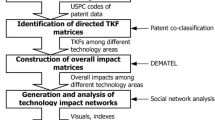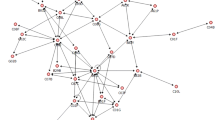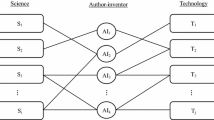Abstract
Rapid technological advancements and increasing research and development (R&D) costs are making it necessary for national R&D plans to identify the coreness and intermediarity of technologies in selecting projects and allocating budgets. Studies on the coreness or intermediarity of technology sectors have used patent citations, but there are limitations to dealing with patent data. The limitations arise from the most current patents and patents that do not require citations, e.g. Korean patents. Further, few or no studies have simultaneously considered both coreness and intermediarity. Therefore, we propose a patent co-classification based method to measure coreness and intermediarity of technology sectors by incorporating the analytic network process and the social network analysis. Using IPC co-classifications of patents as technological knowledge flows, this method constructs a network of directed knowledge flows among technology sectors and measures the long-term importance and the intermediating potential of each technology sector, despite the limitations of patent-based analyses. Considering both coreness and intermediarity, this method can provide more detailed and essential knowledge for decision making in planning national R&D. We demonstrated this method using Korean national R&D patents from 2008 to 2011. We expect that this method will help in planning national R&D in a rapidly evolving technological environment.






Similar content being viewed by others
References
Aragonés-Beltrán, P., Chaparro-González, F., Pastor-Ferrando, J., & Rodríguez-Pozo, F. (2010). An ANP-based approach for the selection of photovoltaic solar power plant investment projects. Renewable and Sustainable Energy Reviews, 14(1), 249–264.
Chen, Z., & Guan, J. (2011). Mapping of biotechnology patents of China from 1995–2008. Scientometrics, 88(1), 73–89.
Chen, J. H., Jang, S.-L., & Wen, S. H. (2010). Measuring technological diversification: Identifying the effects of patent scale and patent scope. Scientometrics, 84(1), 265–275.
Cho, T. S., & Shih, H. Y. (2011). Patent citation network analysis of core and emerging technologies in Taiwan: 1997–2008. Scientometrics, 89(3), 795–811.
Choi, J. Y., Lee, J. H., & Sohn, S. Y. (2009). Impact analysis for national R&D funding in science and technology using quantification method II. Research Policy, 38(10), 1534–1544.
Dolfsma, W., & Seo, D. (2013). Government policy and technological innovation—a suggested typology. Technovation, 33(6–7), 173–179.
Evenson, R., & Puttnam, J. (1988). The Yale-Canada patent flow concordance. New Haven: Yale University.
Fier, A., Aschhoff, B., & Löhlein, H. (2006). Behavioural additionality of public R&D funding in Germany. Government R&D Funding and Company Behaviour: Measuring Behavioural Additionality, 127.
Freeman, L. C. (1977). A set of measures of centrality based on betweenness. Sociometry, 40(1), 35–41.
Freeman, L. C. (2004). The development of social network analysis: A study in the sociology of science (Vol. 1). Vancouver: Empirical Press.
Galende, J., & de la Fuente, J. M. (2003). Internal factors determining a firm’s innovative behaviour. Research Policy, 32(5), 715–736.
Gilsing, V., Nooteboom, B., Vanhaverbeke, W., Duysters, G., & Van Den Oord, A. (2008). Network embeddedness and the exploration of novel technologies: Technological distance, betweenness centrality and density. Research Policy, 37(10), 1717–1731.
Grupp, H., & Schmoch, U. (1992). Perceptions of scientification of innovation as measured by referencing between patents and papers: Dynamics in science-based fields of technology. In Dynamics of science-based innovation (pp. 73–128). Berlin: Springer.
Gu, X., Cai, C., Song, H., & Song, J. (2009). Research on R&D project risk management model. Cutting-Edge Research Topics on Multiple Criteria Decision Making, 552–558.
Guan, J., & He, Y. (2007). Patent-bibliometric analysis on the Chinese science—technology linkages. Scientometrics, 72(3), 403–425.
Hall, B. H., Jaffe, A. B., & Trajtenberg, M. (2001). The NBER patent citation data file: Lessons, insights and methodological tools. Cambridge: National Bureau of Economic Research.
Han, Y. J., & Park, Y. (2006). Patent network analysis of inter-industrial knowledge flows: The case of Korea between traditional and emerging industries. World Patent Information, 28(3), 235–247.
Hanneman, R. A., & Riddle, M. (2005). Introduction to social network methods. Riverside: University of California.
Holbrook, J. A., & Jang, J. G. (2006). Development of a methodology to evaluate the feasibility of public R&D investments in new technologies in Korea. STEPI working paper. Washington DC: Science and Technology Policy Institute.
Hsu, F. M., Horng, D. J., & Hsueh, C. C. (2009). The effect of government-sponsored R&D programmes on additionality in recipient firms in Taiwan. Technovation, 29(3), 204–217.
Jaffe, A. B. (1986). Technological opportunity and spillovers of R&D: Evidence from firms’ patents, profits and market value. National Bureau of Economic Research Cambridge, Mass., USA.
Johnson, D. K. N. (2002). The OECD Technology Concordance (OTC): Patents by industry of manufacture and sector of use. Paris: OECD Publishing.
Jung, U., & Seo, D. (2010). An ANP approach for R&D project evaluation based on interdependencies between research objectives and evaluation criteria. Decision Support Systems, 49(3), 335–342.
Karvonen, M., & Kässi, T. (2012). Patent citations as a tool for analysing the early stages of convergence. Technological Forecasting and Social Change, 80(6), 1094–1107.
Kim, C., Lee, H., Seol, H., & Lee, C. (2011). Identifying core technologies based on technological cross-impacts: An association rule mining (ARM) and analytic network process (ANP) approach. Expert Systems with Applications, 38(10), 12559–12564.
Kortum, S., & Putnam, J. (1997). Assigning patents to industries: Tests of the Yale Technology Concordance. Economic Systems Research, 9(2), 161–176.
Krafft, J., Quatraro, F., & Saviotti, P. P. (2011). The knowledge-base evolution in biotechnology: A social network analysis. Economics of Innovation and New Technology, 20(5), 445–475.
Lee, H., Kim, C., Cho, H., & Park, Y. (2009). An ANP-based technology network for identification of core technologies: A case of telecommunication technologies. Expert Systems with Applications, 36(1), 894–908.
Lee, H., Kim, C., & Park, Y. (2010). Evaluation and management of new service concepts: An ANP-based portfolio approach. Computers & Industrial Engineering, 58(4), 535–543.
Leydesdorff, L. (2008). Patent classifications as indicators of intellectual organization. Journal of the American Society for Information Science and Technology, 59(10), 1582–1597.
Lim, H., & Park, Y. (2010). Identification of technological knowledge intermediaries. Scientometrics, 84(3), 543–561.
Liu, C., Shan, W., & Yu, J. (2011). Shaping the interdisciplinary knowledge network of China: A network analysis based on citation data from 1981 to 2010. Scientometrics, 89(1), 89–106.
Mohanty, R., Agarwal, R., Choudhury, A., & Tiwari, M. (2005). A fuzzy ANP-based approach to R&D project selection: A case study. International Journal of Production Research, 43(24), 5199–5216.
Nelson, A. J. (2009). Measuring knowledge spillovers: What patents, licenses and publications reveal about innovation diffusion. Research Policy, 38(6), 994–1005.
Park, Y. T., & Kim, M. S. (1999). A taxonomy of industries based on knowledge flow structure. Technology Analysis & Strategic Management, 11(4), 541–549.
Park, J., Lee, H., & Park, Y. (2009). Disembodied knowledge flows among industrial clusters: A patent analysis of the Korean manufacturing sector. Technology in Society, 31(1), 73–84.
Patel, P., & Pavitt, K. (1994). The continuing, widespread (and neglected) importance of improvements in mechanical technologies. Research Policy, 23(5), 533–545.
Saaty, T. L. (1996). Decision making with dependence and feedback: The analytic network process.
Saaty, T. L. (2004). Fundamentals of the analytic network process—Dependence and feedback in decision-making with a single network. Journal of Systems Science and Systems Engineering, 13(2), 129–157.
Saaty, T. L. (2005). Theory and applications of analytic network process (Vol. 4922). Pittsburgh: RWS publications.
Schmoch, U., Laville, F., Patel, P., & Frietsch, R. (2003). Linking technology areas to industrial sectors. Final Report to the European Commission, DG Research.
Scott, J. (2000). Social network analysis: A handbook. London: Sage Publications Limited.
Verspagen, B. (1997). Measuring intersectoral technology spillovers estimates from the European and US patent office databases. Economic Systems Research, 9(1), 47–65.
Verspagen, B., van Moergastel, T., & Slabbers, M. (1994). MERIT concordance table: IPC-ISIC (rev. 2): Merit.
Wang, X., Zhang, X., & Xu, S. (2011). Patent co-citation networks of Fortune 500 companies. Scientometrics, 88(3), 761–770.
Yoo, S. H., Lee, Y. H., & Won, D. K. (2007). A study on the measurement of technological impact using citation analysis of patent information. Journal of Korea Technology Innovation Society, 10(2), 687–705.
Yoon, J., Choi, S., & Kim, K. (2011). Invention property-function network analysis of patents: A case of silicon-based thin film solar cells. Scientometrics, 86(3), 687–703.
Zha, X., & Chen, M. (2010). Study on early warning of competitive technical intelligence based on the patent map. Journal of Computers, 5(2), 274–281.
Zhang, J., & Baden-Fuller, C. (2009). The influence of technological knowledge base and organizational structure on technology collaboration. Journal of Management Studies, 47(4), 679–704.
Acknowledgments
We feel much appreciation for the editor and anonymous reviewers who provided valuable comments and suggestions on the earlier version of this paper. This work was supported by Basic Science Research Program through the National Research Foundation of Korea (NRF) funded by the Ministry of Science, ICT & Future Planning (No. 2012R1A1A1039303).
Author information
Authors and Affiliations
Corresponding author
Appendix
Rights and permissions
About this article
Cite this article
Park, H., Yoon, J. Assessing coreness and intermediarity of technology sectors using patent co-classification analysis: the case of Korean national R&D. Scientometrics 98, 853–890 (2014). https://doi.org/10.1007/s11192-013-1109-2
Received:
Published:
Issue Date:
DOI: https://doi.org/10.1007/s11192-013-1109-2




